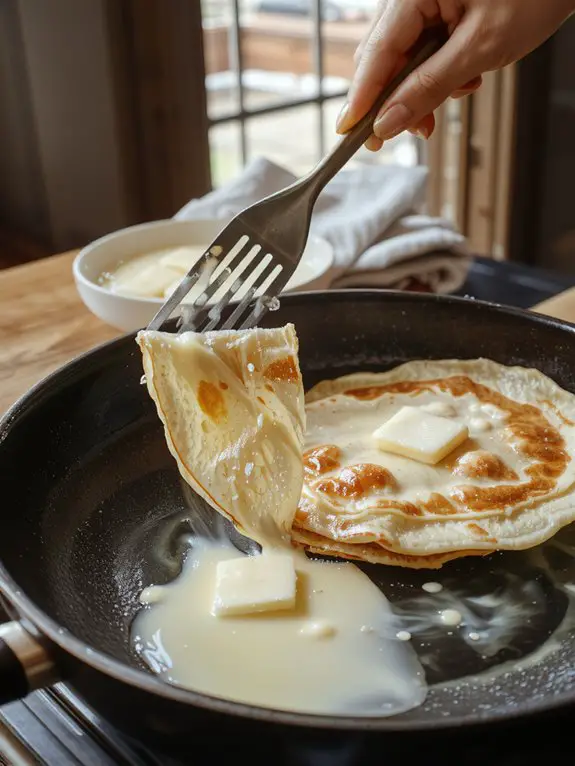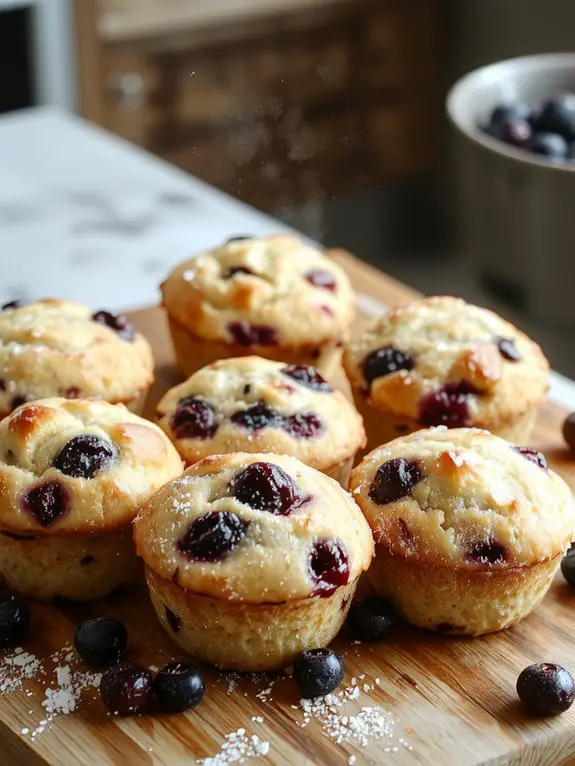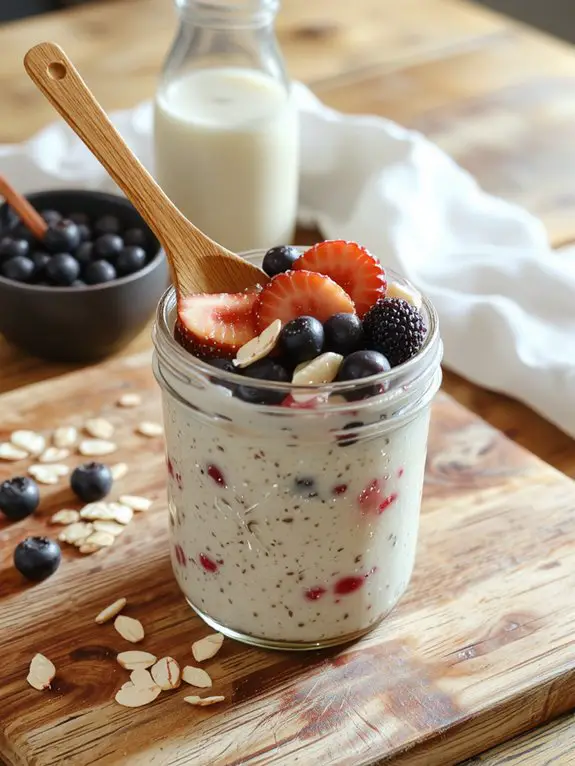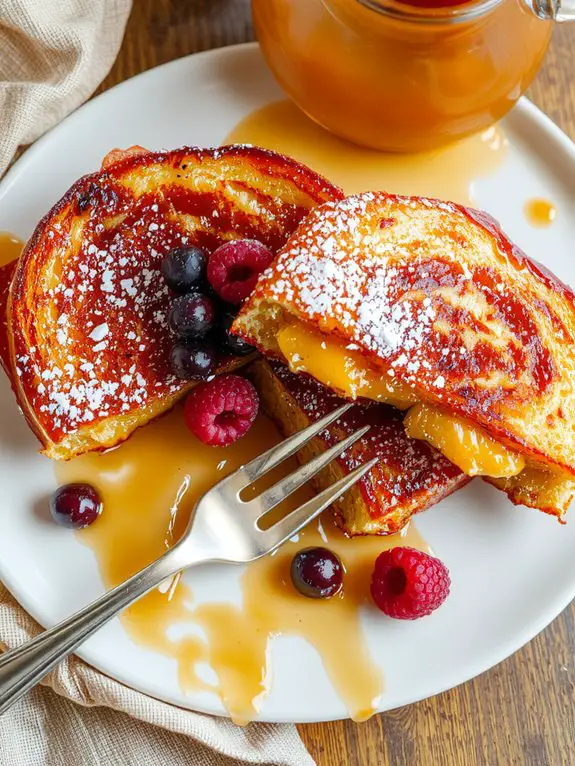I’ve spent years perfecting this crepe recipe, and I can tell you that most people make one critical mistake that ruins the entire batch. The difference between paper-thin, delicate crepes and thick, rubbery disappointments comes down to a technique that French chefs guard closely. Once you master this simple but essential step, you’ll never struggle with crepe-making again.
Recipe
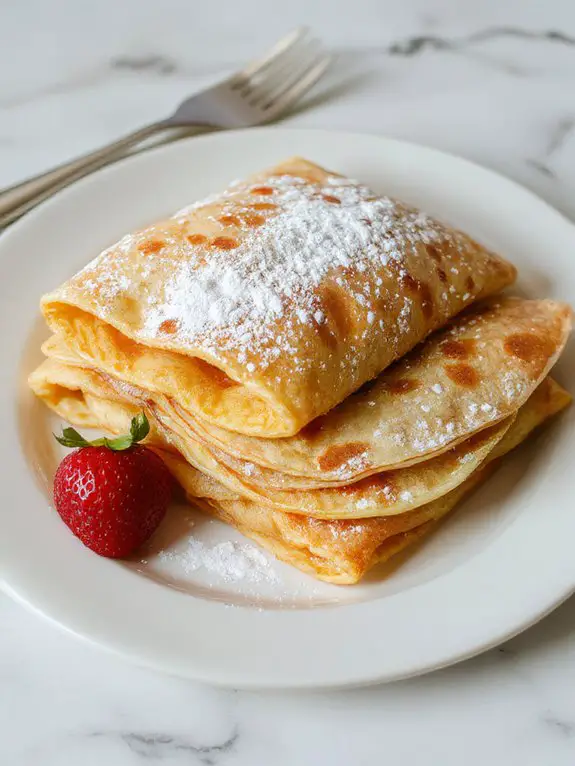
I can tell you with absolute certainty that this is the only crepe recipe you’ll ever need—delicate, buttery, and so perfectly tender they practically melt on your tongue. After years of experimenting with different ratios and techniques, I’ve cracked the code for crepes that are impossibly thin yet never tear, with just the right amount of vanilla sweetness and that gorgeous golden color that makes them look bakery-perfect every single time.
The secret is in letting the batter rest (trust me on this!) and using the perfect milk-to-egg ratio that creates crepes so silky and pliable you can fold them into elegant parcels or roll them up with whatever filling your heart desires.
Whether you’re drizzling them with fresh lemon juice and powdered sugar for a classic French experience or stuffing them with Nutella and strawberries for pure indulgence, these crepes have that magical combination of buttery richness and delicate texture that makes every bite feel special.
The best part? Once you get the hang of swirling the batter in the pan (and you’ll after just a couple tries), you’ll be flipping these beauties like a pro and wondering why you ever thought crepe-making was intimidating.
Ingredients
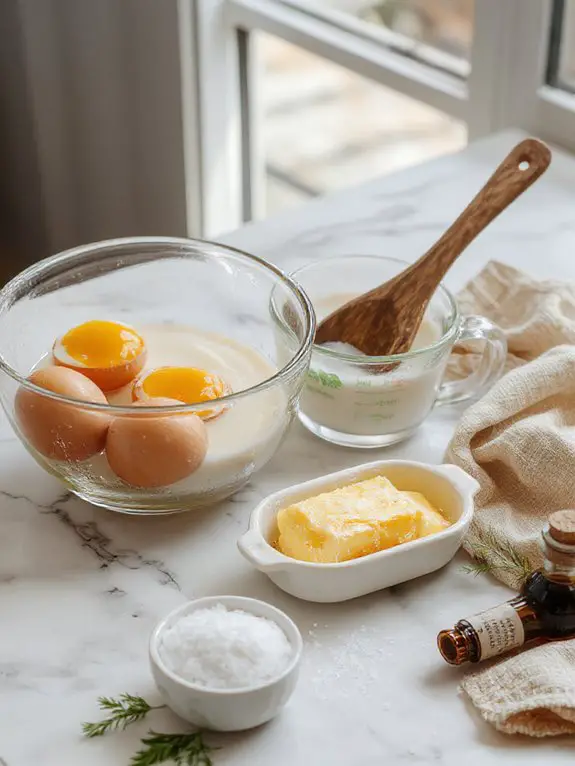
The secret to perfect crepes lies in the simplicity and quality of your ingredients—every single one plays an essential role in creating those delicate, paper-thin pancakes that French chefs have perfected over centuries.
Here’s the insider scoop: room temperature ingredients are your best friend for achieving that silky-smooth batter, and don’t you dare skip the resting time that allows the flour to fully hydrate.
Essential Base Ingredients:
- All-purpose flour – The backbone of your crepes; measure it properly by spooning into the cup and leveling off (no scooping straight from the bag!)
- Large eggs – Must be room temperature for seamless mixing; cold eggs will create lumps that’ll haunt your batter
- Whole milk – The richness factor that creates tender crepes; low-fat milk works but sacrifices that luxurious texture
- Melted butter – This is non-negotiable for flavor and prevents sticking; vegetable oil works in a pinch but butter is king
- Salt – Just a pinch, but it’s the difference between flat and flavorful crepes
Flavor Enhancers:
- Granulated sugar – Even for savory crepes, a touch balances the batter and aids in browning
- Vanilla extract – Pure vanilla only; artificial tastes cheap and you’ll notice the difference
Smart Substitutions:
- No whole milk? Mix ¾ cup any milk with ¼ cup heavy cream for richness
- Dairy-free option? Unsweetened almond milk plus a tablespoon of melted coconut oil works beautifully
- Gluten-free swap? Use a 1:1 gluten-free flour blend, but add an extra egg for structure
How to Make the Best Perfect French Crepe Recipe
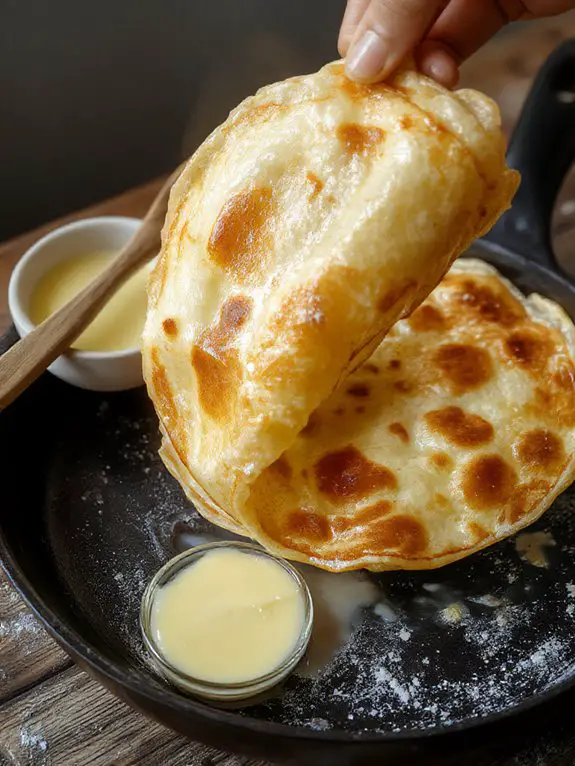
Rest the batter for at least 30 minutes, or up to 24 hours in the fridge. This resting period allows the flour to fully hydrate and any air bubbles to settle, resulting in incredibly smooth, elegant crepes. The gluten also relaxes during this time, making the crepes more tender. Cover the bowl to prevent a skin from forming on top.
Give the batter a gentle stir before cooking, and thin if needed. After resting, the batter may thicken slightly. Stir gently—just enough to make it uniform again. The perfect consistency should coat the back of a spoon but still pour easily.
If it’s too thick, add milk one tablespoon at a time until it flows like heavy cream.
Heat your pan over medium heat and test the temperature before starting. The pan is ready when a drop of water sizzles and evaporates within 2-3 seconds. Too hot and the crepes will bubble and burn; too cool and they’ll be thick and rubbery.
An 8-10 inch non-stick or well-seasoned crepe pan works best, but a regular skillet works too.
Use just enough butter to lightly coat the pan between crepes. A quick swipe with a paper towel dipped in melted butter is perfect. Too much butter creates greasy crepes and causes uneven browning. You want just enough to prevent sticking and add that subtle buttery flavor to each crepe.
Pour the batter and immediately swirl the pan to create paper-thin crepes. Use about ¼ cup of batter for an 8-inch pan, pouring it into the center while simultaneously lifting and tilting the pan in a circular motion. Work quickly—you have about 3-4 seconds before the batter sets.
The goal is an even, translucent layer that covers the entire bottom of the pan.
Cook the first side until the edges are set and lightly golden. This takes about 1-2 minutes over medium heat. You’ll know it’s ready when the edges start to curl slightly and the surface looks mostly set with just a few moist spots.
The bottom should be lightly golden with beautiful lacy edges—this is what gives crepes their signature appearance.
Flip with confidence using a thin spatula or your fingers for the authentic touch. Slide a thin spatula under one edge and quickly flip, or use the traditional French method of loosening the edges and flipping with your fingertips.
The second side only needs 30-60 seconds—just enough to set and create a few golden spots. Don’t worry if your first crepe isn’t perfect; it’s considered the cook’s test crepe!
Stack finished crepes on a plate and cover to keep warm and prevent drying. Place a clean kitchen towel over the stack to maintain moisture and warmth.
Crepes can be made several hours ahead and reheated gently, or even frozen for up to three months with parchment paper between each one. They’re incredibly versatile and reheat beautifully for quick meals later.
Chef Tips
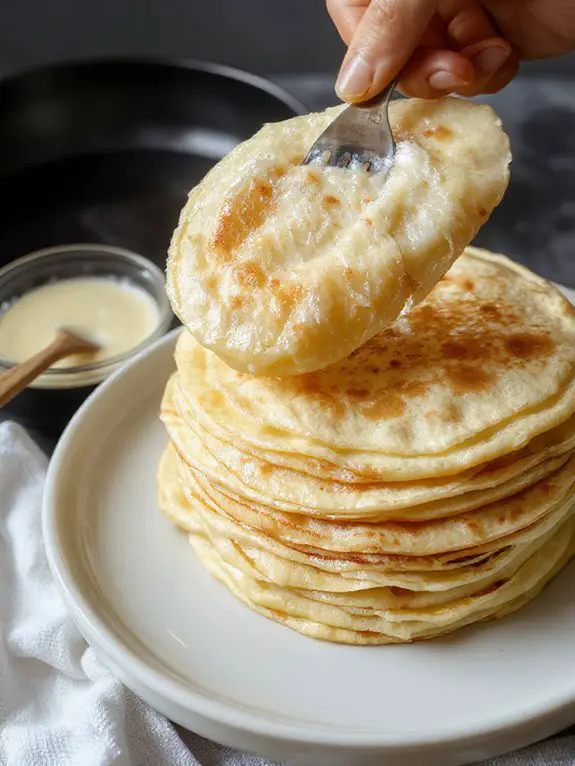
While mastering the basic technique is essential, there are several professional secrets that’ll elevate your crepes from good to restaurant-quality.
I always let my batter rest overnight for smoother texture.
Sharp knife skills guarantee clean edges when cutting garnishes.
Focus on plating technique—fold crepes consistently and arrange toppings with intention for stunning presentation.
Nutrition
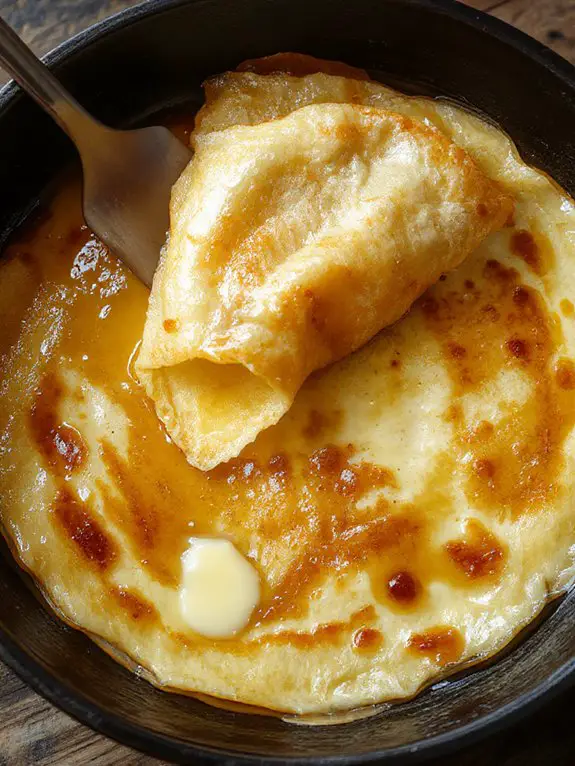
A basic crepe contains approximately 80-120 calories per serving, depending on size and ingredients used. The nutritional profile varies based on the specific recipe and toppings added.
| Nutrient | Per Crepe (medium, 8-inch) |
|---|---|
| Calories | 90 |
| Protein | 3.2g |
| Carbohydrates | 11g |
| Total Fat | 3.5g |
| Saturated Fat | 1.8g |
| Cholesterol | 65mg |
| Sodium | 85mg |
| Fiber | 0.4g |
| Sugar | 1.5g |
| Calcium | 45mg |
| Iron | 0.8mg |
| Vitamin A | 120 IU |
| Vitamin B12 | 0.2mcg |
What You’ll Love About This Recipe
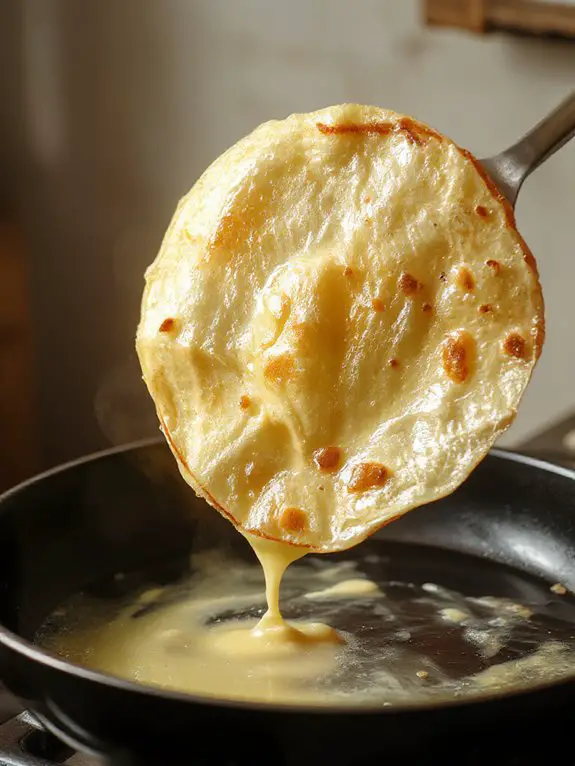
These delicate, paper-thin pancakes bring a touch of French elegance to your kitchen, and they’re surprisingly simple to make with ingredients you probably already have on hand. Whether you’re planning a special breakfast, an impressive brunch, or a cozy weekend treat, this versatile recipe will become your go-to favorite for creating memorable moments around the table.
Quick and Easy Preparation – With just a few basic ingredients and a simple mixing technique, you can have the batter ready in under 10 minutes. This makes these crepes perfect for both planned meals and spontaneous cooking adventures.
Endless Filling Possibilities – From sweet options like fresh berries, chocolate, and whipped cream to savory combinations featuring cheese, herbs, and vegetables, these neutral-flavored crepes serve as the perfect canvas for whatever flavors you’re craving.
Impressive Results Every Time – Despite their elegant appearance, these crepes are forgiving for beginners while still delivering restaurant-quality results. This will have your family and friends thinking you’ve mastered a complex culinary skill.
Recipe Card
This classic crepe recipe creates delicate, paper-thin pancakes that are perfect for both sweet and savory fillings. With just a few simple ingredients and the right technique, you’ll master these versatile French treats that can be enjoyed for breakfast, lunch, dinner, or dessert.
Ingredients:
- 1 cup all-purpose flour
- 2 large eggs
- 1¼ cups whole milk
- 2 tablespoons melted butter
- 1 tablespoon granulated sugar
- ¼ teaspoon salt
- Additional butter for cooking
Instructions:
- In a large bowl, whisk together flour, eggs, milk, melted butter, sugar, and salt until smooth. Let batter rest for 30 minutes at room temperature.
- Heat a non-stick skillet or crepe pan over medium heat. Lightly butter the pan.
- Pour ¼ cup of batter into the center of the pan and immediately tilt and rotate the pan to spread batter evenly across the bottom.
- Cook for 1-2 minutes until the edges are lightly golden and the crepe easily lifts from the pan.
- Flip carefully and cook for another 30-60 seconds.
- Transfer to a plate and repeat with remaining batter, adding butter to pan as needed.
Notes:
The batter should be thin enough to coat the pan easily when swirled. If too thick, add milk 1 tablespoon at a time.
Crepes can be made ahead and stored in the refrigerator for up to 3 days or frozen for up to 1 month with parchment paper between each crepe.
Equipment:
Non-stick skillet or crepe pan, whisk, measuring cups and spoons, ladle or ¼ cup measure
Time:
Prep time: 10 minutes (plus 30 minutes resting)
Cooking time: 20 minutes
Cuisine: French
Serving: Makes 8-10 crepes, serves 4

